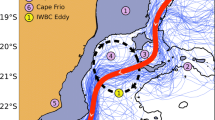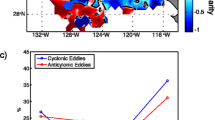Abstract
Loop Current Eddies (LCEs) are warm-core, anticyclonic rings that shed from the Loop Current and migrate westward providing kinetic and potential energy to the Gulf of Mexico (GoM). Typically, LCEs dissipate through interaction with the western shelf slope, other mesoscale eddies, and diapycnal mixing. Here, we explore a case where a LCE, Eddy Poseidon, encountered Hurricane Harvey in the northwest GoM in August 2017 causing its rapid dissipation. This interaction significantly reduced Poseidon’s areal extent, dynamic height, heat content, and kinetic energy. Using in situ observations and numerical model output, we explore Poseidon’s dissipation and show it was caused by a combination of processes. A rigorous cold wake formed along Poseidon’s east, strong hurricane-induced surface currents transported shelf water towards the eddy on its north and west sides, and heat was lost throughout the water column from Poseidon’s southern edge. Horizontal advection was greatest at the surface and decreased with depth—27% of heat lost from Poseidon occurred in the top 100 m and 47% from the top 200 m.








Similar content being viewed by others
Data availability
All data are freely available. Argo data were downloaded from www.argo.ucsd.edu. Copernicus model output was downloaded from E. U. Copernicus Marine Service Information www.marine.copernicus.eu. Hurricane data was downloaded from the National Hurricane Center Atlantic hurricane database (HURDAT2) https://www.nhc.noaa.gov/data/#hurdat.
Code availability
Not applicable.
References
Argo (2000). Argo float data and metadata from Global Data Assembly Centre (Argo GDAC). SEANOE https://doi.org/10.17882/42182
Bender LC III, Guinasso NL Jr, Walpert JN, Lee LL III, Martin RD, Hetland RD et al (2007) Development, operation, and results from the Texas automated buoy system. Gulf Mex Sci 25(1):4
Biggs DC, Fargion GS, Hamilton P, Leben RR (1996) Cleavage of a Gulf of Mexico Loop Current eddy by a deep water cyclone. J Geophys Res Oceans 101(C9):20629–20641
Blake, E. S., & Zelinsky, D. A. (2018). National Hurricane center tropical cyclone report: Hurricane Harvey. National Hurricane Center, National Oceanographic and Atmospheric Association.
Bosart LF, Bracken WE, Molinari J, Velden CS, Black PG (2000) Environmental influences on the rapid intensification of Hurricane Opal (1995) over the Gulf of Mexico. Mon Weather Rev 128(2):322–352
Brooks DA (1983) The wake of Hurricane Allen in the western Gulf of Mexico. J Phys Oceanogr 13(1):117–129
Chelton DB, DeSzoeke RA, Schlax MG, El Naggar K, Siwertz N (1998) Geographical variability of the first baroclinic Rossby radius of deformation. J Phys Oceanogr 28(3):433–460
Chen X, Qiu B, Chen S, Qi Y, Du Y (2015) Seasonal eddy kinetic energy modulations along the North Equatorial Countercurrent in the western Pacific. J Geophys Res Oceans 120(9):6351–6362
Cho K, Reid RO, Nowlin WD Jr (1998) Objectively mapped stream function fields on the Texas-Louisiana shelf based on 32 months of moored current meter data. J Geophys Res Oceans 103(C5):10377–10390
Cooper C, Forristall GZ, Joyce TM (1990) Velocity and hydrographic structure of two Gulf of Mexico warm-core rings. J Geophys Res Oceans 95(C2):1663–1679
Darnell, R. M. (2015). The American sea: a natural history of the Gulf of Mexico. Texas A&M University Press.
D’Asaro EA (2003) The ocean boundary layer below Hurricane Dennis. J Phys Oceanogr 33(3):561–579. https://doi.org/10.1175/1520-0485(2003)033_0561:TOBLBH_2.0.CO;2
DiMarco, S. F., Walpert, J., Knap, A. H., Whilden, K., Lee, L. L., & Buschang, S. (2018). Coastal Ocean Observations of Hurricane Harvey (2017) from the Texas Automated Buoy System . Ocean Sciences Meeting. Portland, Oregon: American Geophysical Union.
Donohue KA, Watts DR, Hamilton P, Leben R, Kennelly M (2016) Loop current eddy formation and baroclinic instability. Dyn Atmos Oceans 76:195–216
Dukhovskoy DS, Leben RR, Chassignet EP, Hall CA, Morey SL, Nedbor-Gross R (2015) Characterization of the uncertainty of loop current metrics using a multidecadal numerical simulation and altimeter observations. Deep Sea Res Part I: Oceanogr Res Pap 100:140–158
Elsberry R, Fraim T, Trapnell R Jr (1976) A mixed layer model of the oceanic thermal response to hurricanes. J Geophy Res 81:1153–1162. https://doi.org/10.1029/JC081i006p01153
Forristall GZ, Schaudt KJ, Cooper CK (1992) Evolution and kinematics of a Loop Current eddy in the Gulf of Mexico during 1985. J Geophys Res Oceans 97(C2):2173–2184
Fratantoni PS, Lee TN, Podesta GP, Muller-Karger F (1998) The influence of Loop Current perturbations on the formation and evolution of Tortugas eddies in the southern Straits of Florida. J Geophys Res Oceans 103(C11):24759–24779
Geisler JE (1970) Linear theory of the response of a two layer ocean to a moving hurricane. Geophysical and Astrophysical Fluid Dynamics 1(1–2):249–272
Ginis I (2002) Tropical cyclone-ocean interactions. Adv Fluid Mech 33:83–114
Gonella, J. (1972). A rotary-component method for analyzing meteorological and oceanographic vector time series. In Deep Sea Research and Oceanographic Abstracts (Vol. 19, No. 12, pp. 833–846). Elsevier.
Hall CA, Leben RR (2016) Observational evidence of seasonality in the timing of Loop Current eddy separation. Dyn Atmos Oceans 76:240–267
Hamilton P, Lugo-Fernández A, Sheinbaum J (2016) A Loop Current experiment: Field and remote measurements. Dyn Atmos Oceans 76:156–173
Huang P, Sandford TB, Imberger J (2009) Heat and turbulent kinetic energy budgets for surface layer cooling induced by the passage of Hurricane Frances (2004). J Geophys Res 114:C12023. https://doi.org/10.1029/2009JC005603
Hong X, Chang SW, Raman S (2007) Modification of the loop current warm core eddy by Hurricane Gilbert (1988). Nat Hazards 41(3):501–514
Hyun, K. H., & Hogan, P. J. (2008). Topographic effects on the path and evolution of Loop Current Eddies. J Geophys Res Oceans, 113(C12).
Intra-Americas sea circulation. The Sea: The Global Coastal Ocean, A. Robinson and K. H. Brink, Eds., Regional Studies and Syntheses, Vol. 11, Wiley and Sons, 183–208
Jaimes B, Shay LK (2009) Mixed layer cooling in mesoscale oceanic eddies during Hurricanes Katrina and Rita. Mon Weather Rev 137(12):4188–4207
Jaimes B, Shay LK, Brewster JK (2016) Observed air-sea interactions in tropical cyclone Isaac over Loop Current mesoscale eddy features. Dyn Atmos Oceans 76:306–324
Jacob SD, Shay LK (2003) The role of oceanic mesoscale features on the tropical cyclone–induced mixed layer response: a case study. J Phys Oceanogr 33(4):649–676
Jullien, S., Menkès, C. E., Marchesiello, P., Jourdain, N. C., Lengaigne, M., Koch-Larrouy, A., ... & Faure, V. (2012). Impact of tropical cyclones on the heat budget of the South Pacific Ocean. J Phys Oceanogr, 42(11), 1882-1906
Jordan, C. L., and N. L. Frank (1964), On the influence of tropical cyclones on the sea surface temperature field, in Proceedings of Symposium on Tropical Meteorology, pp. 614–622, N. Z. Meteorol. Serv., Wellington. on Tropical Meteorology, pp. 614–622, N. Z. Meteorol. Serv., Wellington.
Kolodziejczyk N, Ochoa J, Candela J, Sheinbaum J (2011) Deep currents in the Bay of Campeche. Journal of Physical Oceanography 41(10):1902–1920
Landsea CW, Franklin JL (2013) Atlantic Hurricane Database Uncertainty and Presentation of a New Database Format. Mon Wea Rev 141:3576–3592
Lellouche, J. M., Legalloudec, O., Regnier, C., Levier, B., Greiner, E., & Drevillon, M. (2019). Quality Information Document for For Global Sea Physical Analysis and Forecasting Product GLOBAL_ANALYSIS_FORECAST_PHY_001_024. https://resources.marine.copernicus.eu/documents/QUID/CMEMS-GLO-QUID-001-024.pdf
Leben, R. R. (2005), Altimeter-derived loop current metrics, in Circulation in the Gulf of Mexico: observations and models, Geophys. Monogr. Ser., vol. 161, edited by W. Sturges and A. Lugo-Fernandez, pp. 181–201, AGU, Washington, D. C.
Le Hénaff, M., Kourafalou, V. H., Morel, Y., & Srinivasan, A. (2012). Simulating the dynamics and intensification of cyclonic Loop Current Frontal Eddies in the Gulf of Mexico. J Geophys Res Oceans, 117(C2).
Lindo-Atichati D, Bringas F, Goni G, Muhling B, Muller-Karger FE, Habtes S (2012) Varying mesoscale structures influence larval fish distribution in the northern Gulf of Mexico. Mar Ecol Prog Ser 463:245–257
Milkov, A. V., Sassen, R., Novikova, I., & Mikhailov, E. (2000). Gas hydrates at minimum stability water depths in the Gulf of Mexico: significance to geohazard assessment.
Mooers CN, Maul GA (1998) Intra-Americas sea circulation. In: Brink KH, Robinson AR (eds) The sea. John Wiley, NY, pp 83–208
Morey, S. L., Martin, P. J., O'Brien, J. J., Wallcraft, A. A., & Zavala‐Hidalgo, J. (2003). Export pathways for river discharged fresh water in the northern Gulf of Mexico. J Geophys Res Oceans, 108(C10).
Morrison JM, Merrell WJ Jr, Key RM, Key TC (1983) Property distributions and deep chemical measurements within the western Gulf of Mexico. J Geophys Res Oceans 88(C4):2601–2608
Muller-Karger, F. E., Smith, J. P., Werner, S., Chen, R., Roffer, M., Liu, Y., ... & Enfield, D. B. (2015). Natural variability of surface oceanographic conditions in the offshore Gulf of Mexico. Progress in Oceanography, 134, 54-76
Nowlin WD, Jochens AE, DiMarco SF, Reid RO, Howard MK (2005) Low-frequency circulation over the Texas-Louisiana continental shelf. Geophys Monogr-Am Geophys Union 161:219
Oey L, Ezer T, Lee H (2005) Loop Current, rings and related circulation in the Gulf of Mexico: a review of numerical models and future challenges. Geophys Monogr-Am Geophys Union 161:31
Oey LY (2008) Loop Current and deep eddies. J Phys Oceanogr 38(7):1426–1449
Pérez-Brunius P, Furey H, Bower A, Hamilton P, Candela J, García-Carrillo P, Leben R (2018) Dominant circulation patterns of the deep Gulf of Mexico. J Phys Oceanogr 48(3):511–529
Potter H, Drennan WM, Graber HC (2017) Upper ocean cooling and air-sea fluxes under typhoons: a case study. J Geophys Res Oceans 122(9):7237–7252
Potter H (2018) The cold wake of typhoon Chaba (2010). Deep Sea Res Part I: Oceanogr Res Pap 140:136–141
Potter H, DiMarco SF, Knap AH (2019) Tropical cyclone heat potential and the rapid intensification of Hurricane Harvey in the Texas Bight. J Geophys Res Oceans 124(4):2440–2451
Price JF (1981) Upper ocean response to a hurricane. J Phys Oceanogr 11(2):153–175. https://doi.org/10.1175/1520-0485(1981)011_0153:UORTAH_2.0.CO;2
Price JF, Sanford TB, Forristall GZ (1994) Forced stage response to a moving hurricane. J Phy Oceanogr 24(2):233–260
Pudov VD, Varfolomeev AA, Fedorov KN (1979) Vertical structure of the wake of a typhoon in the upper ocean. Okeanologiya 21:142–146
Romanou, A., Chassignet, E. P., & Sturges, W. (2004). Gulf of Mexico circulation within a high‐resolution numerical simulation of the North Atlantic Ocean. Journal of Geophysical Research: Oceans, 109(C1).
Shay LK, Black PG, Mariano AJ, Hawkins JD, Elsberry RL (1992) Upper ocean response to Hurricane Gilbert. J Geophys Res Oceans 97(C12):20227–20248
Shay LK, Goni GJ, Black PG (2000) Effects of a warm oceanic feature on Hurricane Opal. Mon Weather Rev 128(5):1366–1383
Spencer LJ, DiMarco SF, Wang Z, Kuehl JJ, Brooks DA (2016) Asymmetric oceanic response to a hurricane: deep water observations during Hurricane Isaac. J Geophys Res Oceans 121(10):7619–7649
Sturges W, Leben R (2000) Frequency of ring separations from the Loop Current in the Gulf of Mexico: a revised estimate. J Phys Oceanogr 30(7):1814–1819
Sutyrin GG, Rowe GD, Rothstein LM, Ginis I (2003) Baroclinic eddy interactions with continental slopes and shelves. J Phys Oceanogr 33(1):283–291
Toner, M., Kirwan Jr, A. D., Poje, A. C., Kantha, L. H., Müller‐Karger, F. E., & Jones, C. K. R. T. (2003). Chlorophyll dispersal by eddy‐eddy interactions in the Gulf of Mexico. J Geophys Res Oceans, 108 (C4).
Vukovich FM, Waddell E (1991) Interaction of a warm ring with the western slope in the Gulf of Mexico. J Phys Oceanogr 21(7):1062–1074
Walker, N. D., Pilley, C. T., Raghunathan, V. V., D’Sa, E. J., Leben, R. R., Hoffmann, N. G., ... & Turner, R. E. (2011). Impacts of Loop Current frontal cyclonic eddies and wind forcing on the 2010 Gulf of Mexico oil spill. Monitoring and Modeling the Deepwater Horizon Oil Spill: A Record-Breaking Enterprise, Geophys. Monogr. Ser, 195, 103-116
Wang X, Wang X, Chu PC (2018) Air-sea interactions during rapid intensification of typhoon Fengshen (2008). Deep Sea Res Part I: Oceanogr Res Pap 140:63–77
Wong, A., Keeley, R., & Carval, T. (2020). Argo quality control manual for CTD and trajectory data.
Funding
This research was funded in part by the Gulf of Mexico Coastal Ocean Observing System (GCOOS) and Texas A&M Department of Oceanography.
Author information
Authors and Affiliations
Corresponding author
Ethics declarations
Competing interests
The authors declare no competing interests.
Additional information
Responsible Editor: Tal Ezer
Rights and permissions
About this article
Cite this article
Potter, H., Hsu, CY. & DiMarco, S.F. Rapid dissipation of a Loop Current eddy due to interaction with a severe Gulf of Mexico hurricane. Ocean Dynamics 71, 911–922 (2021). https://doi.org/10.1007/s10236-021-01471-y
Received:
Accepted:
Published:
Issue Date:
DOI: https://doi.org/10.1007/s10236-021-01471-y




